LA Invitational at Gagosian Gallery
October 26 – December 16, 2017
555 West 24th Street
New York, NY 10011
Gagosian is currently showing “LA Invitational,” a wide-ranging exhibition of works by Los Angeles-based artists Chris Burden, Frank Gehry, Piero Golia, Mark Grotjahn, Thomas Houseago, Alex Israel, Mike Kelley, Nancy Rubins, Sterling Ruby, Ed Ruscha, Robert Therrien, Jeff Wall, Mary Weatherford, and Jonas Wood. Many works have been made specifically for this exhibition, while others are being shown in New York for the first time.
In the popular imagination, the cultural motor of Los Angeles has always been rooted in Hollywood. The exchange between the movie business and the visual arts, however, has had notable impacts on both worlds—clearly discernible in the works of artists such as Kelley, Ruscha, and Israel. From the 1950s, as the entertainment industry increasingly required industrial, artisanal, and artistic skills such as set painting, animation, modeling, and editing, generations of dedicated visual artists both resisted and participated in Los Angeles’s far-reaching cultural boom during the city’s transformation into one of the world’s most influential industrial, economic, and creative capitals.
The landscape of southern California serves as a catalyst for fantasy, from its modernist architecture to its otherworldly rock formations, trees, coastline, mountains, and hills from which twinkling towns and cities can be viewed in the valleys below. Alex Israel’s Sky Backdrop (2016) depicts Los Angeles’s wide skies in scenographic terms, while Mary Weatherford, showing her first large-scale painting since joining Gagosian, captures the shifting atmosphere of the Pacific coast, evoking the sky and sea in painted layers and glowing, neon light. In Jeff Wall’s Property Line (2015), two surveyors mark a patch of dirt on the outskirts of California City, located about 100 miles outside of Los Angeles, capturing the exact moment at which nature is transformed into property.
Writing via press release

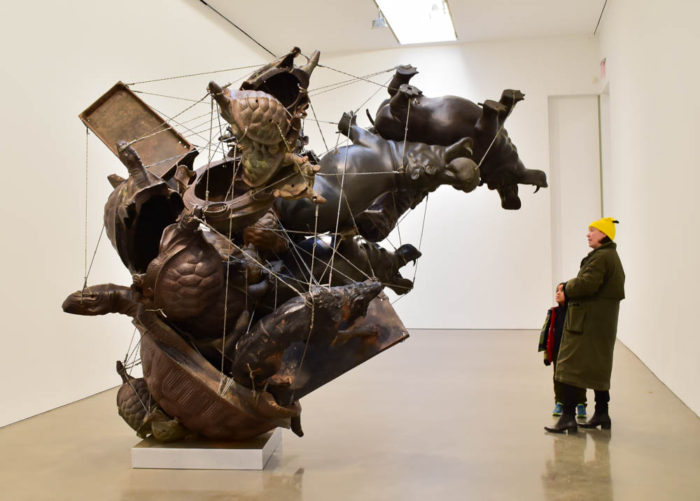

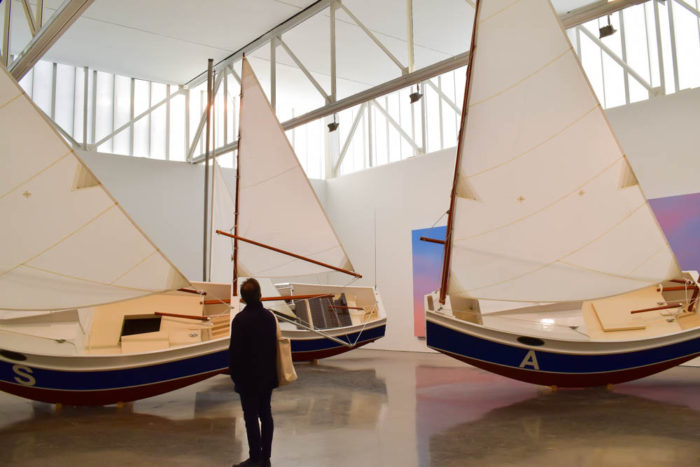
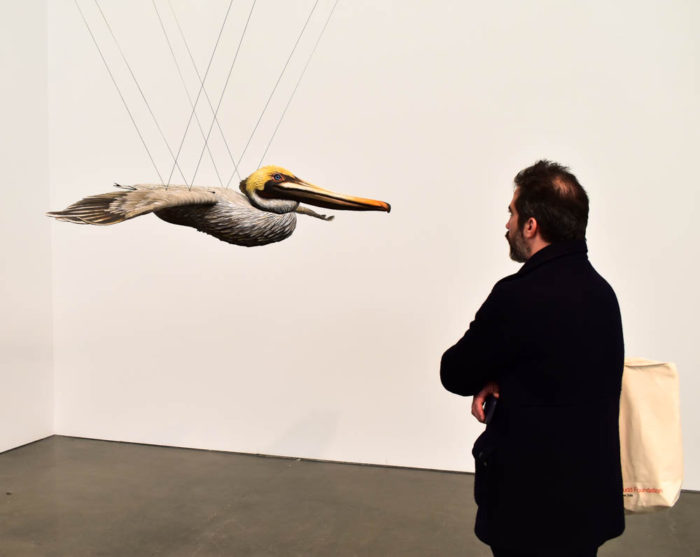
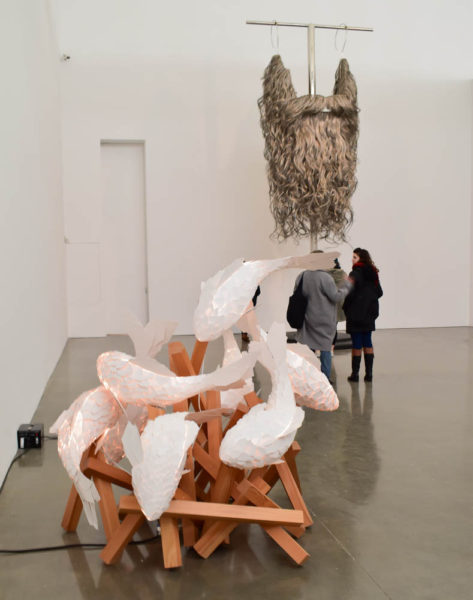
Nina Chanel Abney: Safe House at Mary Boone Gallery
Curated by Piper Marshall in collaboration with Jack Shainman Gallery
November 9 – December 22nd. 2017
541 west 24th street
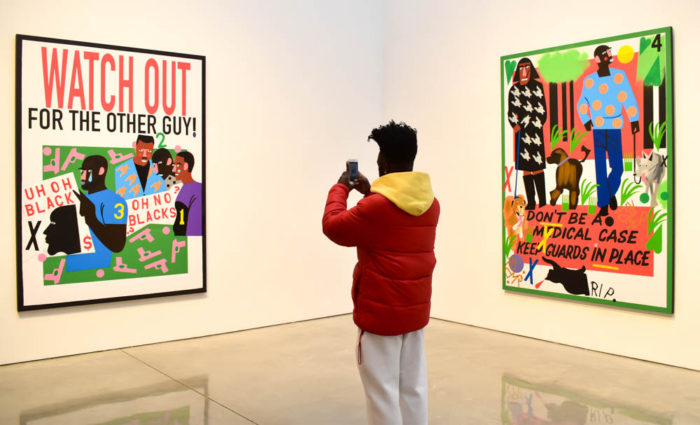
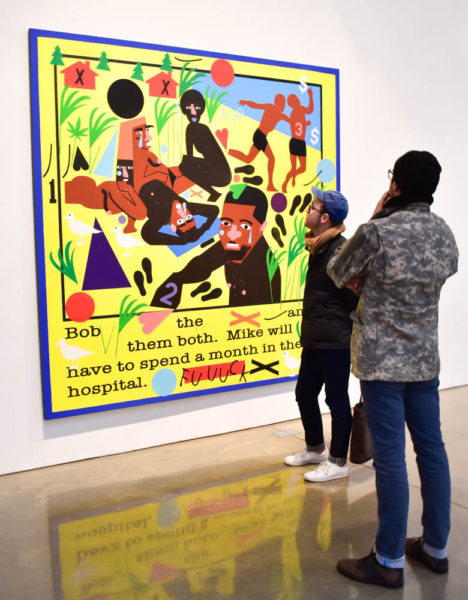
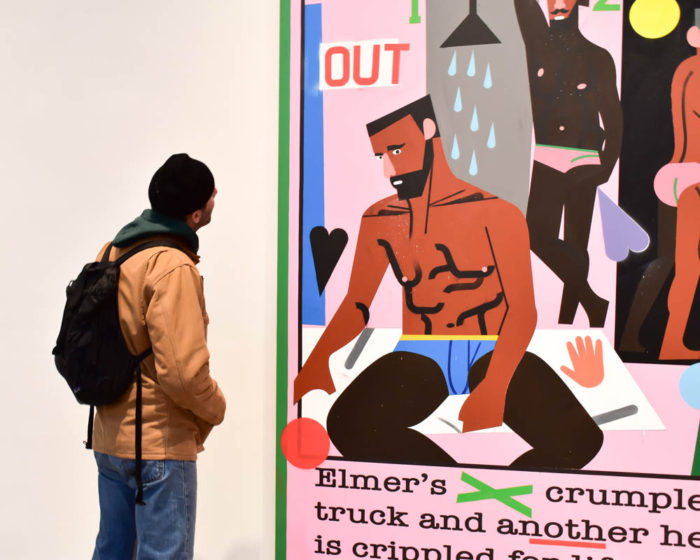
Katharina Fritsch at Matthew Marks Gallery
November 4 – December 22, 2017
523 W 24 Street
Fritsch’s sculpture often begins with a familiar image, which she subverts with shifts in scale and color. The exhibition opens with three such objects greatly enlarged: a lantern in pink and black; an egg, half in yellow and half in orange; and an enormous human skull in white. In the second room are a purple spinning wheel, an oversize blue strawberry, and a large red and white snake.
In 2010 art historian Jean-Pierre Criqui wrote about Fritsch’s depictions of animals: “The way the artist uses them, but also the situations in which she places them, gives them ambiguous powers at the intersection of several tendencies: humanity’s ancestral fears and superstitions, as expressed, for example, in tales and legends; the intensities of totemic thought and of its images; and the uncanny and Freudian dream study.”
In the exhibition’s third room is a bronze sculpture of a cowry shell. Standing almost ten feet tall and painted in a bright pale green, it towers over the viewer. Fritsch first used this shape in pale pink as a component of her 2004 sculpture Woman with Dog. Now isolated and greatly enlarged, the shell engages the viewer’s body directly, its serrated aperture both inviting and menacing, while its matte-green finish transforms the organic form into something disquietingly unfamiliar.
As Fritsch explained in a 2002 interview, “I find this game between reality and vision very interesting. I think my work moves backwards and forwards between these two poles. There is still the connection to the real, but at the same time to the unreal.”
Writing via press release
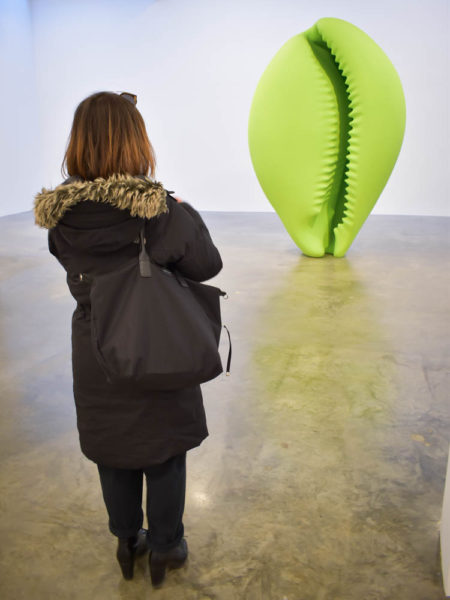
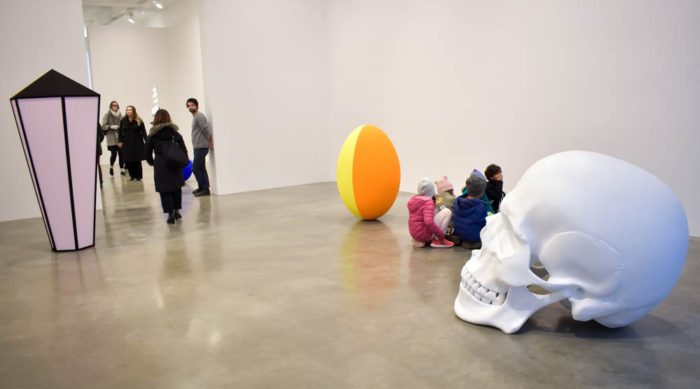

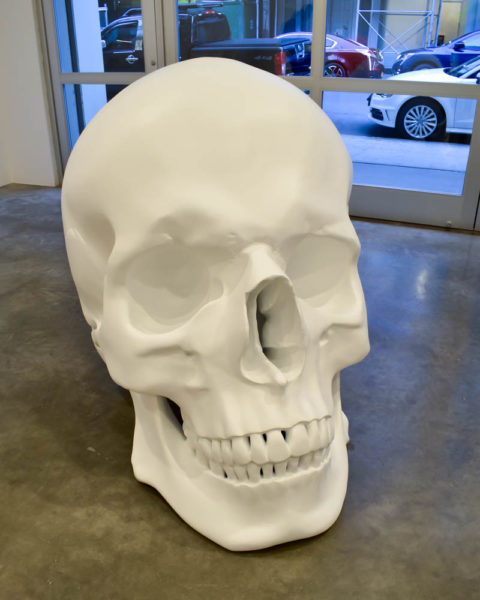
Cary Smith at Fredericks & Freiser
October 19, 2017 – November 18, 2017
536 WEST 24TH STREET, NEW YORK 10011
Fredericks & Freiser is currently showing an exhibition of new paintings and drawings by Cary Smith. Smith’s hard-edged, abstract paintings find their individual character from highly intuitive color interactions, boldly direct paint application, and hand-painted precision.
In this exhibition Smith presents a group of primarily colorful paintings that follow three general manifestations. The first are works in which the compositions evoke universal, seemingly functional design. Symmetrical and Mandala-like, these paintings are logical like game boards or flags. There is a straightforwardness that appears mathematical rather than personal. In contrast, other works have specific forms that evoke a more poetic, portrait-like singularity. The shapes display a gracefulness that is more instinctual. Finally, a single anomalous painting titled A Necessary Coexistence is an amalgamation of both types—rational yet lyrical.
Smith’s paintings are made freehand with a variety of small sable brushes without the use of tape to mask the edges of the areas of color. His surfaces are delicate and warm which stand in contrast to the graphic, geometric compositions and allow them to convey both conceptual and emotional content. His bold colors work much the same way. Smith hones color with exactitude: working and reworking until he develops accurate color chords. This precision creates an energy that is highly experiential and like the paintings as a whole creates a believable space that is familiar yet completely new to the eye.
Writing via press release
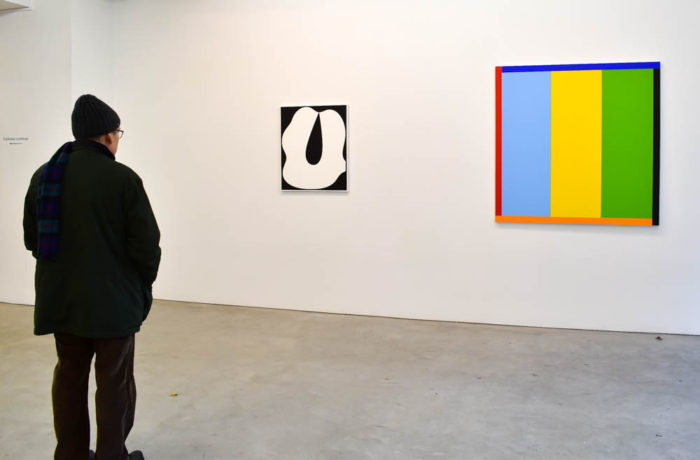
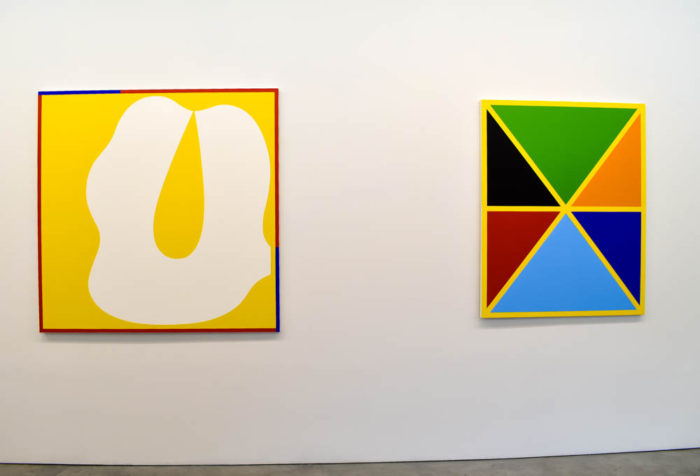
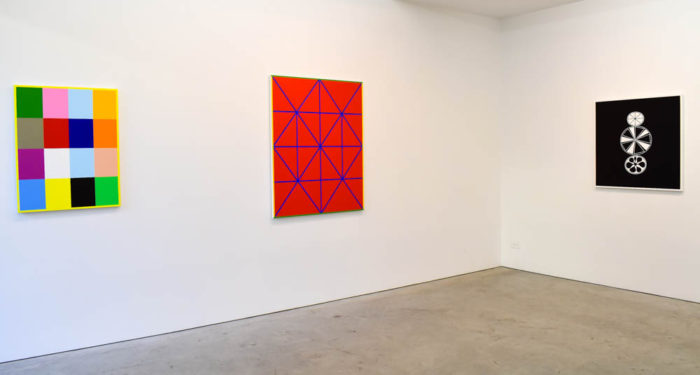
Michelangelo Pistoletto: Scaffali at Luhring Augustine
November 4 – December 22, 2017
531 West 24th Street, New York, NY 10011
Michelangelo Pistoletto (b. 1933, Biella, Italy) is a founding father of the Arte Povera movement and widely regarded as one of the most influential artists of his generation. For over half a century, Pistoletto has sought to merge art and life through sculptural installations, experimental performances, and, most famously, his iconic mirror paintings, which serve as the foundation of his artistic practice. Comprised of photo-silkscreened images on highly polished stainless steel, these signature works were developed in 1962 and represent the artist’s dual interest in conceptualism and figuration. By working with a reflective surface, Pistoletto enables the viewer to become an integral part of the piece while the subject of the work is drawn into the activity of the gallery space.
Scaffali, the Italian word for shelves, brings together a selection of recent mirror paintings whose portrayal of industrial storage units presents a tension between the aesthetic and utilitarian. Among the objects depicted are tools and vessels belonging to various trades, including paint canisters, camera lenses, and automotive parts. While Pistoletto has typically relied on the mirror’s reflective surface to seamlessly integrate pictorial space with the physical space of the viewer, the Scaffali paintings appear to complicate this relationship. The shelves allude to notions of dormancy and stasis, and, as photographic images, they are also emblematic of a fixed time and place. By contrast, the mirror’s reflection of the present moment and its unique capacity to introduce endlessly fluctuating content challenges the inherent stability imposed by the shelf’s frame. As the shelves occupy the majority of the picture plane, thereby minimizing the viewer’s participation, the Scaffali paintings foreground their object-like status and command a strong sculptural presence.
Writing via press release
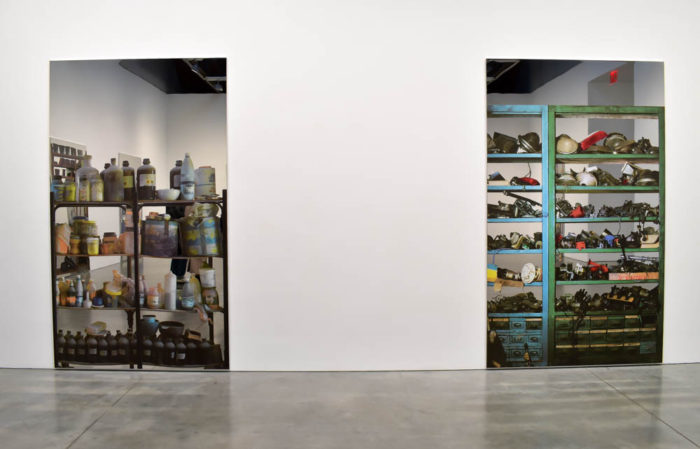
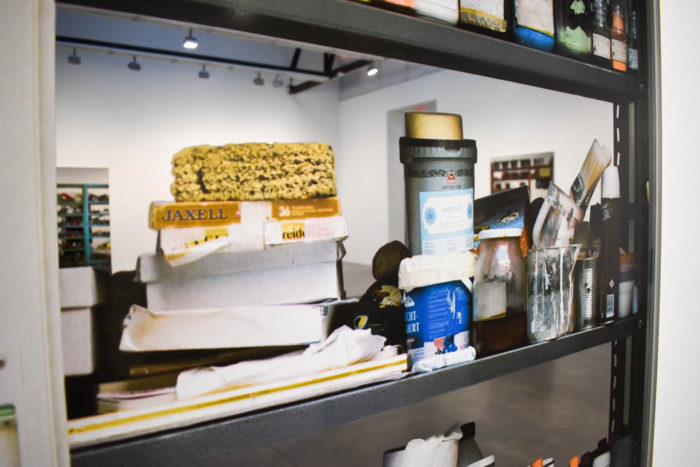
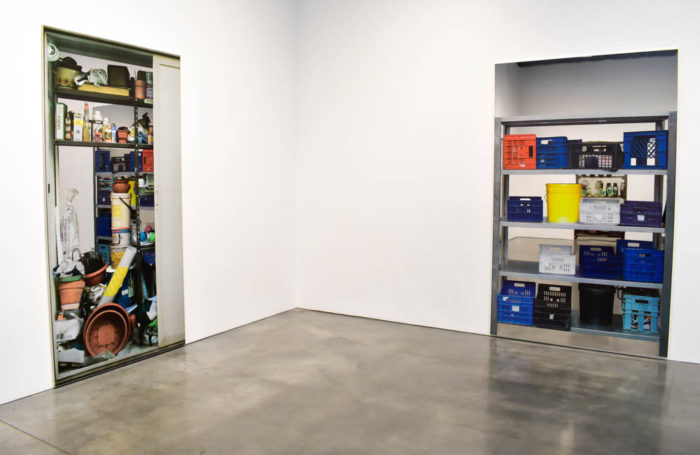
William Villalongo: Keep on Pushing at Susan Inglett Gallery
522 West 24th Street New York NY 10011
October 26 through December 9, 2017
Known for irreverent riffs on the art historical “muse,” William Villalongo has made episodic paintings and works on paper, which underscore historical erasure and master narratives of desire. In his fifth solo exhibition at Susan Inglett Gallery, the artist turns his attention to the black male figure, while returning to his signature cut velvet paper works.
This new body of work suggests a re-imagining of the black male figure at a time when current events and statistics reflect a social reality of limited expectations, contingency, and disproportionate fear. Within the dark tones of these meditations on physiology, the artist uses metaphors of invisibility, nature, and reformation as necessary conditions of being. Much like fallen autumn leaves, Villalongo’s men navigate their world, subject to an unpredictable wind – piling, spinning, and re-collecting. The work conjures spaces of sensuality, humor, and history. Titled after Curtis Mayfield’s 1970 “Keep on Pushing,” Villalongo’s recent body of work speaks to the inherent human spirit’s will to persevere and to find a way.
Writing via press release
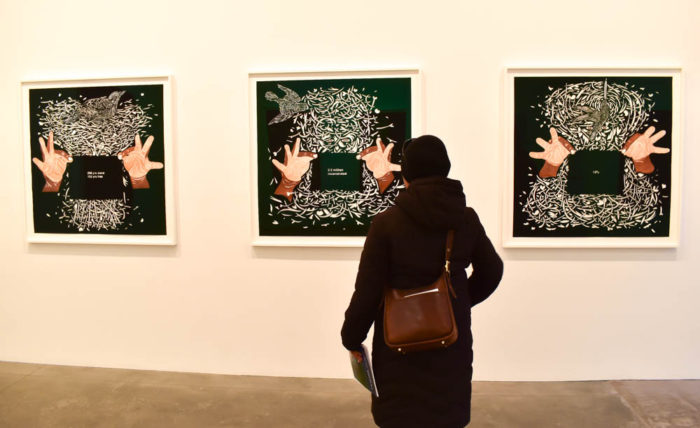
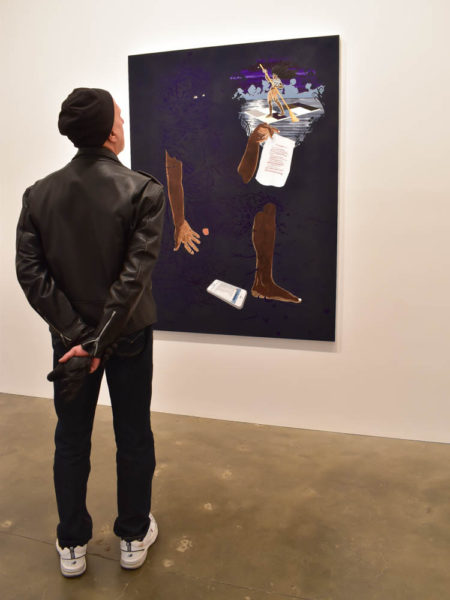

Photos by Jamie Martinez and Arte Fuse
